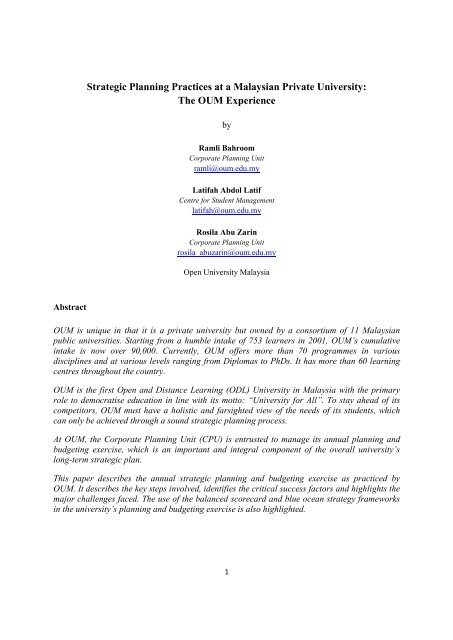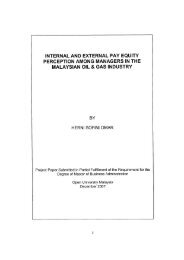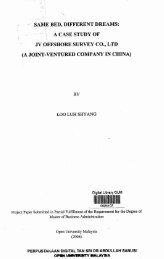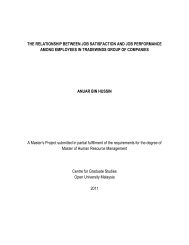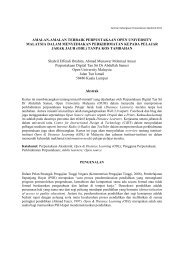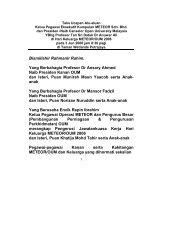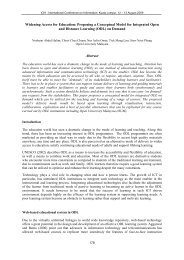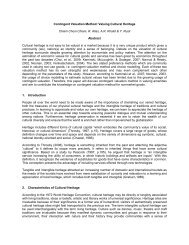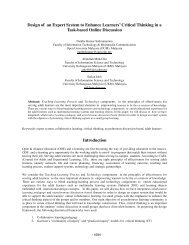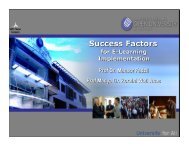Strategic Planning Practices at a Malaysian Private University: The ...
Strategic Planning Practices at a Malaysian Private University: The ...
Strategic Planning Practices at a Malaysian Private University: The ...
Create successful ePaper yourself
Turn your PDF publications into a flip-book with our unique Google optimized e-Paper software.
<strong>Str<strong>at</strong>egic</strong> <strong>Planning</strong> <strong>Practices</strong> <strong>at</strong> a <strong>Malaysian</strong> Priv<strong>at</strong>e <strong>University</strong>:<strong>The</strong> OUM ExperiencebyRamli BahroomCorpor<strong>at</strong>e <strong>Planning</strong> Unitramli@oum.edu.myL<strong>at</strong>ifah Abdol L<strong>at</strong>ifCentre for Student Managementl<strong>at</strong>ifah@oum.edu.myRosila Abu ZarinCorpor<strong>at</strong>e <strong>Planning</strong> Unitrosila_abuzarin@oum.edu.myOpen <strong>University</strong> MalaysiaAbstractOUM is unique in th<strong>at</strong> it is a priv<strong>at</strong>e university but owned by a consortium of 11 <strong>Malaysian</strong>public universities. Starting from a humble intake of 753 learners in 2001, OUM’s cumul<strong>at</strong>iveintake is now over 90,000. Currently, OUM offers more than 70 programmes in variousdisciplines and <strong>at</strong> various levels ranging from Diplomas to PhDs. It has more than 60 learningcentres throughout the country.OUM is the first Open and Distance Learning (ODL) <strong>University</strong> in Malaysia with the primaryrole to democr<strong>at</strong>ise educ<strong>at</strong>ion in line with its motto: “<strong>University</strong> for All”. To stay ahead of itscompetitors, OUM must have a holistic and farsighted view of the needs of its students, whichcan only be achieved through a sound str<strong>at</strong>egic planning process.At OUM, the Corpor<strong>at</strong>e <strong>Planning</strong> Unit (CPU) is entrusted to manage its annual planning andbudgeting exercise, which is an important and integral component of the overall university’slong-term str<strong>at</strong>egic plan.This paper describes the annual str<strong>at</strong>egic planning and budgeting exercise as practiced byOUM. It describes the key steps involved, identifies the critical success factors and highlights themajor challenges faced. <strong>The</strong> use of the balanced scorecard and blue ocean str<strong>at</strong>egy frameworksin the university’s planning and budgeting exercise is also highlighted.1
Introduction<strong>The</strong>re are far too many definitions of str<strong>at</strong>egic planning. A cursory search for the definition ofstr<strong>at</strong>egic planning in the world-wide web through the search engine, Google, revealed a total ofabout 3.33 million listings (Google, 2009). At the top of the list is the definition provided byWikipedia, th<strong>at</strong> is, “<strong>Str<strong>at</strong>egic</strong> planning is an organiz<strong>at</strong>ion's process of defining its str<strong>at</strong>egy, ordirection, and making decisions on alloc<strong>at</strong>ing its resources to pursue this str<strong>at</strong>egy, including itscapital and people” (Wikipedia, 2009). <strong>The</strong> <strong>Str<strong>at</strong>egic</strong> <strong>Planning</strong> Handbook defines it as, “a toolfor organizing the present on the basis of the projections of the desired future” (<strong>Str<strong>at</strong>egic</strong><strong>Planning</strong> Handbook, 2001). Ansoff, who many considers as the f<strong>at</strong>her of str<strong>at</strong>egic management,defines str<strong>at</strong>egic planning as, “a r<strong>at</strong>ional analysis of the opportunities offered by an environmentand of strengths and weaknesses of the firm, and selection of a m<strong>at</strong>ch (str<strong>at</strong>egic) between the twowhich best s<strong>at</strong>isfy the objective of the firm” (Ansoff, 1976). Finally, Drucker, another wellknownmanagement guru defines str<strong>at</strong>egic planning as, “the continuous process of makingpresent entrepreneurial (risk-taking) decisions system<strong>at</strong>ically and with the gre<strong>at</strong>est knowledge oftheir futurity; organizing system<strong>at</strong>ically the efforts needed to carry out these decisions; andmeasuring the results of these decisions against the expect<strong>at</strong>ions through organized, system<strong>at</strong>icfeedback (Drucker, 1974).Having provided the various definitions of str<strong>at</strong>egic planning, we move on to discuss itsimportance in the context of a university. <strong>Str<strong>at</strong>egic</strong> planning as a process was migr<strong>at</strong>ed from thecorpor<strong>at</strong>e world and has been practiced in some universities for <strong>at</strong> least 40 years (Fain, 2007).However, its use has exploded only in the last decade and now virtually every university has inplace some form of a str<strong>at</strong>egic planning process. <strong>The</strong> sudden rise in str<strong>at</strong>egic planning activitiesamong universities may be <strong>at</strong>tributable to the following higher educ<strong>at</strong>ion trends: increasingintensity of competition, globaliz<strong>at</strong>ion and the rise of borderless educ<strong>at</strong>ion, increasing costs ofrunning a university, reduced funding for public universities, learners’ diversity of needs andgre<strong>at</strong>er accountability and emphasis on quality corpor<strong>at</strong>e governance. Examining the possibilitiesand formul<strong>at</strong>ing str<strong>at</strong>egies to meet those challenges can help the institution take full advantage ofopportunities and minimize thre<strong>at</strong>s. In short, it can take control of its future. It can use itsenergies and resources more effectively and conduct its core business more successfully, despitechanges in the environment.Wh<strong>at</strong> constitutes a good str<strong>at</strong>egic planning exercise? <strong>The</strong> liter<strong>at</strong>ure is filled with manysuggestions and recommend<strong>at</strong>ions on this subject m<strong>at</strong>ter. However, in our opinion, an effectivestr<strong>at</strong>egic management process has to have the following: Firstly, it has to be a particip<strong>at</strong>oryprocess whereby all members of the organiz<strong>at</strong>ion have to be made aware of its content and moreimportantly particip<strong>at</strong>e directly in the formul<strong>at</strong>ion of the plan. This is necessary to ensure th<strong>at</strong>each member has a claim to its ownership. Secondly, as the name implies, it has to be str<strong>at</strong>egic inn<strong>at</strong>ure. Though this is r<strong>at</strong>her obvious, it is not easy to put it to practice. Furthermore, it is moreeasily st<strong>at</strong>ed than done. Unless, the str<strong>at</strong>egic planning process has gone through a rigorous2
str<strong>at</strong>egic analysis stage, the eventual str<strong>at</strong>egic plan will not provide the much needed competitiveadvantage for the institution.Finally, the ultim<strong>at</strong>e goal of a str<strong>at</strong>egic plan is to achieve excellence. In this regard, it is oftenobserved th<strong>at</strong> traditionally, universities usually confined their goals to academic excellence. Inthe current context of higher educ<strong>at</strong>ion environment, this is a rel<strong>at</strong>ively narrow and noncomprehensivegoal. For completeness, two other goals need to be incorpor<strong>at</strong>ed, th<strong>at</strong> is, serviceand organis<strong>at</strong>ional excellence (Ruben, 2001). Service excellence refers to how we cre<strong>at</strong>e andmaintain a cordial rel<strong>at</strong>ionship with learners through teaching, research and community services.Organis<strong>at</strong>ional excellence on the other hand concerns the effectiveness and efficiency of the waywe discharge our day-to-day duties or our internal processes. Dysfunctional work processes th<strong>at</strong>pervade many higher educ<strong>at</strong>ion institutions are gre<strong>at</strong> time-wasters, inhibit innov<strong>at</strong>ion anddemoralize the institutions’ staff. Worst still, it has high potential to interfere the institutions’ability to better serve their learners and other external service providers.Objective and scope of paper<strong>The</strong> objective of the paper is to present and share the str<strong>at</strong>egic planning practices <strong>at</strong> Open<strong>University</strong> Malaysia (OUM), the country’s first open and distance learning (ODL) university.Since the area and context of str<strong>at</strong>egic planning is r<strong>at</strong>her vast and the space limit<strong>at</strong>ion afforded bythis paper is obviously limited, this paper will focus only on one of the critical components of itsoverall str<strong>at</strong>egic planning process, th<strong>at</strong> is the annual planning and budgeting exercise. Morespecifically the paper will describe the key steps involved, identify the critical success factorsand highlight the major challenges faced. Since inception, the university has been using thebalanced scorecard framework as its primary str<strong>at</strong>egic planning and implement<strong>at</strong>ion tool; thisframework will be elabor<strong>at</strong>ed in the paper. Finally, since recently, the team has introduced anadditional and complementary tool, the blue ocean str<strong>at</strong>egy in the university’s str<strong>at</strong>egic planningprocess; this will also be highlighted in the paper.OUM: Malaysia’s first ODL <strong>University</strong>OUM is the first Open and Distance Learning (ODL) <strong>University</strong> in Malaysia. Its vision is “to bethe leading provider of flexible learning” and its mission is to widen access to quality educ<strong>at</strong>ionand provide lifelong learning opportunities by leveraging on technology, adopting flexible modeof learning, and providing a conducive and engaging learning environment <strong>at</strong> competitive andaffordable cost.” Its primary role is to contribute towards the democr<strong>at</strong>is<strong>at</strong>ion of educ<strong>at</strong>ion in linewith its motto of “<strong>University</strong> for All”.3
OUM is unique in th<strong>at</strong> it is a priv<strong>at</strong>e university but owned by a consortium of 11 <strong>Malaysian</strong>public universities. Starting from a humble intake of 753 learners in 2001, OUM’s cumul<strong>at</strong>iveintake is now over 90,000. Currently, OUM offers more than 70 programmes in variousdisciplines and <strong>at</strong> various levels ranging from Diplomas to PhDs. It has more than 60 learningcentres throughout the country. To d<strong>at</strong>e, it has produced more than 13,000 gradu<strong>at</strong>es and <strong>at</strong> itsSeventh Convoc<strong>at</strong>ion in November this year, more than 7,000 of its learners will gradu<strong>at</strong>ebringing the total to more than 20,000 gradu<strong>at</strong>es. On the intern<strong>at</strong>ional front, we have successfullyestablished learning centres in Bahrain, Yemen, the Maldives, Indonesia, Singapore, and Ghanaand in the very near future, Vietnam. Thus, it is evident th<strong>at</strong> OUM has grown <strong>at</strong> a very rapid pacein a rel<strong>at</strong>ively short span of time (9 years). This remarkable achievement is due to many factors,one of which is its effective str<strong>at</strong>egic planning process.<strong>The</strong> str<strong>at</strong>egic planning process <strong>at</strong> OUM takes cognizance of its primary role in providing lifelonglearning, enriching learners’ experience and democr<strong>at</strong>ising educ<strong>at</strong>ion through affordable,accessible and flexible learning. A large majority of OUM’s learners are working adults whorequire gre<strong>at</strong>er learner support when compared to learners in the conventional universities. <strong>The</strong>provision of these supports forms one of the critical str<strong>at</strong>egic thrusts of the <strong>University</strong>’s str<strong>at</strong>egicplan. As a rel<strong>at</strong>ively young institution, with all its challenges, OUM would as much as possibleavoid having to spend most of its time reacting to unexpected changes instead of anticip<strong>at</strong>ing andpreparing for them. When caught in such a crisis management, it will spend too much time andenergy with the immedi<strong>at</strong>e problems, leaving little energy left to anticip<strong>at</strong>e and prepare for thenext set of challenges. This forms the r<strong>at</strong>ionale for the critical need of str<strong>at</strong>egic planning.From our experience, the three ingredients to successful str<strong>at</strong>egic planning and implement<strong>at</strong>ionare commitment, credibility, and communic<strong>at</strong>ion. Up-front commitment by all leaders, such asHODs means th<strong>at</strong> they have to adhere to the full and thorough process of str<strong>at</strong>egic planning.Input, feedback, and understanding are crucial <strong>at</strong> every step. Everyone should provide inputsand, ideally, everyone should feel a sense of ownership over the final plan. Such personalcommitment will facilit<strong>at</strong>e the implement<strong>at</strong>ion process. Another useful approach used by OUMis in tre<strong>at</strong>ing the str<strong>at</strong>egic plan as the “benchmark" for progress. <strong>The</strong> str<strong>at</strong>egic plan thenautom<strong>at</strong>ically becomes a system of accountability.Despite of the impressive progress of OUM, staff has been constantly reminded never to rest onits laurels and be complacent with wh<strong>at</strong> it has achieved so far. OUM has to continually strive toinnov<strong>at</strong>e and improve all aspects of its oper<strong>at</strong>ions so as to maintain its leading position in ODLin this country. In this regard, OUM must have a holistic and farsighted view of the needs of itslearners, and this can be achieved through a sound str<strong>at</strong>egic planning process.4
<strong>Str<strong>at</strong>egic</strong> <strong>Planning</strong> <strong>Practices</strong> <strong>at</strong> OUMAt OUM, the Corpor<strong>at</strong>e <strong>Planning</strong> Unit (CPU) is entrusted to manage its annual planning andbudgeting exercise, which is an important and integral component of the overall university’slong-term str<strong>at</strong>egic planning process. <strong>The</strong> role of CPU in this regard is to manage, coordin<strong>at</strong>e,monitor, plan, implement, report and review the entire planning and budgeting process of theuniversity. However, the credit for the success of OUM’s planning and budgeting exercise (PBE)is not due to the unit alone. Without the undivided cooper<strong>at</strong>ion of the departmental heads and alltheir staff and inexorable support from the top management of the university, the exercise wouldnot have been as successful as it is.<strong>The</strong> steps in the annual PBE <strong>at</strong> OUM is shown in Figure 1. It commences with the AnnualBusiness Policy Address (ABPA) delivered by the university’s President/Vice-chancellor whichprovides the business directions, basic str<strong>at</strong>egies and broad targets for the various oper<strong>at</strong>ing units(OPUs) to align to and achieve in the coming planning and budgeting year. It is usually held inthe month of August each year.After ABPA, a planning and budgeting workshop will be held by CPU. <strong>The</strong> workshop will be<strong>at</strong>tended by the various Heads of Departments (HODs) together with their respective BudgetCoordin<strong>at</strong>ors (BCs). <strong>The</strong> str<strong>at</strong>egies and targets were meticulously deliber<strong>at</strong>ed <strong>at</strong> the workshopwith a view of developing the necessary action plans or initi<strong>at</strong>ives to implement the str<strong>at</strong>egiesand achieve the targets. After the successful completion of the workshop, the OPUs will beginpreparing their departmental plans and budgets within the specified time frame. <strong>The</strong> first draft ofthe plans and budgets will then be submitted by the respective OPUs to CPU for an initialreview. CPU will scrutinise the plans and budgets to ensure th<strong>at</strong> they are fully aligned with thestr<strong>at</strong>egies and targets set in ABPA. Any inconsistencies in the plans and over- or underbudgetingwill be further deliber<strong>at</strong>ed with the respective OPUs until they are elimin<strong>at</strong>ed.Once the plans and budgets have been agreed upon by CPU, the departments will beginfinalising their present<strong>at</strong>ion and submission to the <strong>Planning</strong> and Budgeting Committee (PBC), <strong>at</strong>op management committee comprising of the President/Vice Chancellor, as the Chairman andthe other members of the Group Management Committee (GMC). During the present<strong>at</strong>ion, eachHOD will have the opportunity to present and justify its departmental plans and budgets for thecoming year and as well as the issues th<strong>at</strong> need to be resolved <strong>at</strong> the top management level.5
Figure 1: Key Steps in the <strong>Planning</strong> and Budgeting Exercise <strong>at</strong> Open <strong>University</strong> MalaysiaANNUALBUSINESSPOLICYADDRESSBC TO HOLDDISCUSSIONWITH HOD & DEPTSTAFFBC TO PREPAREKPBIs & PPTBC SUBMIT KPBIS &PPT TO CPU FORCONFIRMATION& APPROVALPRESENTATIONTO PBC BY HEADFOR APPROVAL1. Str<strong>at</strong>egy Map2. Plans for 20103. Plans for 2011 – 20154. Staffing requirement5. Student Projection6. Wh<strong>at</strong> activities/tasks/functionsetc th<strong>at</strong> can be Elimin<strong>at</strong>ed,Reduced, Raised & Cre<strong>at</strong>ed –ERRC Grid1. Revenues: all revenuecentres2. Oper<strong>at</strong>ing Expenses(i) Primary Activities(ii) HR Costs(iii) General & Admincosts3. Capital ExpendituresBC AMMEND KPBI& PPT IFREQUIREDBOARDAPPROVED OFBUDGETDEPTIMPLEMENTSPLANS & BUDGETAfter all the departmental plans and budgets have been approved by PBC, CPU will then coll<strong>at</strong>eand consolid<strong>at</strong>e them to develop the university-level plans and budgets for the final present<strong>at</strong>ionand submission to the university’s Board of Directors (BOD). Upon the approval of BOD, theplans and budgets will be dissemin<strong>at</strong>ed to the various departments for their implement<strong>at</strong>ion,starting from 1 January of the coming year.Implement<strong>at</strong>ion and monitoring of departmental plans and budgets<strong>The</strong> implement<strong>at</strong>ion of the departmental plans and budgets is monitored by CPU via two sets ofonline systems. <strong>The</strong> first is called the i-campus where all the expenditures incurred by thedepartments will be keyed in to the system by the Finance Department based on the budget codeof each of the budget line items. At the end of each calendar quarter, these departmentalexpenditures will be summarised and presented in the form or a Quarterly Management Report(QMR) for th<strong>at</strong> quarter. Two sets of reports will be presented, namely variance analysis, which6
compares the actual expenditure against th<strong>at</strong> of its budget and year-on-year analysis whichcompares current quarter performance against th<strong>at</strong> of the same quarter of the previous year.<strong>The</strong>se QMRs are specially constructed report based on the Balanced Scorecard (BSC) frameworkof Norton and Kaplan (Norton & Kaplan, 1996) which consists of the departmental keyperformance indic<strong>at</strong>ors (KPIs) c<strong>at</strong>egorised into BSC’s four perspectives: Financial, Customer,Internal Process and Learning and Growth (Figure 2). <strong>The</strong> report is presented online in the formof a dashboard and made available to the top management of the university for review <strong>at</strong> alltimes. <strong>The</strong> variance and year-on-year performance of each department are evalu<strong>at</strong>ed using thetypical traffic light system of BSC. An additional evalu<strong>at</strong>ion is carried out for faculties and thedistributed st<strong>at</strong>e learning centres which share a common set of KPIs in their respectivec<strong>at</strong>egories. In this exercise, they are ranked against each other to evalu<strong>at</strong>e their compar<strong>at</strong>iveperformances. Annual departmental performances are one of the primary inputs in the annualstaff performance appraisal for the year.Figure 2: Balanced Scorecard FrameworkFinancial:Wh<strong>at</strong> are ourFinancial Measuresof our Success?InternalProcess:To S<strong>at</strong>isfy ourCustomers, wh<strong>at</strong>Business ProcessesVision&MissionCustomer:To Achieve theFinancial Objectives,How do we S<strong>at</strong>isfy ourCustomers?Learning &Growth:How will we Sustainour Ability to Changeand Improve?Critical success factors (CSFs) for a successful planning and budgeting exerciseImplementing the university’s PBE is not without its own and unique challenges. <strong>The</strong>sechallenges vary in terms of their source and intensity. However, the following factors are criticalin determining the success of the exercise.7
Institutional leadership<strong>The</strong> first and foremost success factor for PBE <strong>at</strong> OUM is the support from the top management.It is not an exagger<strong>at</strong>ion to st<strong>at</strong>e th<strong>at</strong> without the crucial and inexorable support from topmanagement, CPU will face many insurmountable obstacles in implementing the university’sannual PBE. <strong>The</strong> commitment of top management particularly the President/Vice Chancellor inadvoc<strong>at</strong>ing all the necessary ingredients and activities of PBE is vital as this will result in agre<strong>at</strong>er cooper<strong>at</strong>ion from the various departments. In short, the top management provides theleadership to inspire and motiv<strong>at</strong>e the organis<strong>at</strong>ion to change.Ownership and accountability<strong>The</strong> second CSF is the particip<strong>at</strong>ion in the planning and budgeting processes. This can beachieved via three innov<strong>at</strong>ive activities of the exercise. <strong>The</strong> first is the appointment andrecognition of the services of the departmental BCs. BCs’ primary role is to assist his or herHOD to formul<strong>at</strong>e his or her departmental plans and budgets for the coming year. <strong>The</strong> directinvolvement of the BCs and HODs in the university’s PBE implies th<strong>at</strong> it is a bottom-up as wellas a top-down process. This involvement also implies ownership of the plans and budgets andaccountability for their achievements which in turn improves responsibility and morale of thedepartmental staff. Implement<strong>at</strong>ion will falter if there is a lack of commitment from the staff.Monitoring and Reporting: Leveraging on ICTAnother critical success factor in PBE <strong>at</strong> OUM is the use of ICT in its implement<strong>at</strong>ion.Leveraging on ICT, quarterly performance evalu<strong>at</strong>ion is carried out online and made accessibleto all parties concerned, particularly the top management and the relevant departments. Thisprovides immedi<strong>at</strong>e alerts and early signals for rectific<strong>at</strong>ion and remedi<strong>at</strong>ion. On the part of topmanagement, any serious misalignment or underperformance by a department can be brought totheir immedi<strong>at</strong>e <strong>at</strong>tention and measures may be instituted to assist the affected department toimprove itself. It is indeed a win-win situ<strong>at</strong>ion.<strong>Str<strong>at</strong>egic</strong> thinking cultureAs mentioned above, for a str<strong>at</strong>egic plan to be effective, it has to be str<strong>at</strong>egic in orient<strong>at</strong>ion andphilosophy. It must be formul<strong>at</strong>ed with a str<strong>at</strong>egic intent on the part of the departments and willgre<strong>at</strong>ly depend upon the str<strong>at</strong>egic thinking capability of the HODs. In the early days of theimplement<strong>at</strong>ion of PBE, HODs are focused on day-to-day oper<strong>at</strong>ions, <strong>at</strong> the expense ofobjectivity and cre<strong>at</strong>ivity, which are the essential ingredients of a good and effective planningprocess. As a result, their plans and budgets are mundane and routine with very little focus onstr<strong>at</strong>egic content. Fortun<strong>at</strong>ely, through several str<strong>at</strong>egic awareness initi<strong>at</strong>ives such as envisioningand alignment workshops, HODs are now more capable in formul<strong>at</strong>ing str<strong>at</strong>egic initi<strong>at</strong>ives intheir plans and budgets. At OUM, str<strong>at</strong>egy maps in the BSC framework are developed by each8
department to guide the departments in their str<strong>at</strong>egic thinking process, as well as to align theirdepartmental str<strong>at</strong>egies to th<strong>at</strong> of the <strong>University</strong>.Innov<strong>at</strong>ion cultureRecently, CPU took the initi<strong>at</strong>ive to incorpor<strong>at</strong>e one of the components in the Blue OceanStr<strong>at</strong>egy (BOS) framework in OUM’s PBE, namely the Elimin<strong>at</strong>e-Reduce-Raise-Cre<strong>at</strong>e (ERRC)Grid (Figure 3). It is mand<strong>at</strong>ory for each department to include its ERRC Grid in their plans andbudgets present<strong>at</strong>ion to PBC. This has gener<strong>at</strong>ed the innov<strong>at</strong>ive interests among the departmentsto reassess their activities to determine which of them could be elimin<strong>at</strong>ed, reduced or raised.<strong>The</strong> departments also need to explore and cre<strong>at</strong>e new activities to further improve theiroper<strong>at</strong>ions and performance.Figure 3: ERRC GridConclusionWhile the success of a young higher educ<strong>at</strong>ion institution like OUM depends on many criticalfactors, we believe th<strong>at</strong> an effective str<strong>at</strong>egic planning process is certainly one of them. <strong>Str<strong>at</strong>egic</strong>planning is an effective tool in plotting the direction of an institution; however it in itself cannotforetell exactly how the future scenario will evolve and wh<strong>at</strong> issues will surface l<strong>at</strong>er in time inorder to successfully plan our organis<strong>at</strong>ional str<strong>at</strong>egy. In this regard, str<strong>at</strong>egic innov<strong>at</strong>ion andtinkering with the str<strong>at</strong>egic plan is an essential str<strong>at</strong>egy to ensure th<strong>at</strong> the institution survive inthe current err<strong>at</strong>ic and turbulent higher educ<strong>at</strong>ion business. In other words, while a str<strong>at</strong>egic plan9
should be consistent and reliable to enable it to serve as a useful guide to our future actions, itshould be flexible enough to allow for continuous improvements brought about by highlyuncertain future environment.ReferencesAnsoff, H.I., (1976). Managing str<strong>at</strong>egic surprise by response to weak signals. CaliforniaManagement Review, 20(2), 21-33.Drucker, P., (1974). “Management: Tasks, Responsibilities and <strong>Practices</strong>.” New York: Harper &Row.Fain, P. (2007). Vision for Excellence. <strong>The</strong> Chronicle of Higher Educ<strong>at</strong>ion, October 5.http://chronicle.com/article/Vision-for-Excellence/4138/. Retrieved on 24 October 2009.Kaplan, R. S. and Norton, D. P. (1996) “Balanced Scorecard: Transl<strong>at</strong>ing Str<strong>at</strong>egy into Action.”Boston: Harvard Business School PressKaplan, R. S. and Norton, D. P. (2001) “<strong>The</strong> Str<strong>at</strong>egy-Focused Organis<strong>at</strong>ion: How BalancedScorecard Companies Thrives in the New Business Environment.” Boston: Harvard BusinessSchool PressKaplan, R. S. and Norton, D. P. (2004) “Str<strong>at</strong>egy Maps: Converting Intangible Assets intoTangible Outcomes.” Boston: Harvard Business School PressKaplan, R. S. and Norton, D. P. (2006) “Alignment: Using the Balanced Scorecard to Cre<strong>at</strong>eCorpor<strong>at</strong>e Synergies.” Boston: Harvard Business School PressRuben, B.D. (2001). We Need Excellence Beyond the Classroom. <strong>The</strong> Chronicle of HigherEduc<strong>at</strong>ion, July 13. http://chronicle.com/article/We-Need-Excellence-Beyond-t/13679/. Retrievedon 24 October 2009.Special Library Associ<strong>at</strong>ion. (2001). ‘<strong>Str<strong>at</strong>egic</strong> <strong>Planning</strong> Handbook.’http://www.sla.org/pdfs/sphand.pdf. Retrieved on 24 October 2009.W. Chan Kim and Renée Mauborgne. (2005). “Blue Ocean Str<strong>at</strong>egy: How to Cre<strong>at</strong>e UncontestedMarket Space and Make Competition Irrelevant.” Boston: Harvard Business School Press.Wikipedia (2009). http://en.wikipedia.org/wiki/<strong>Str<strong>at</strong>egic</strong>_planning. Retrieved on 24 October2009.10


